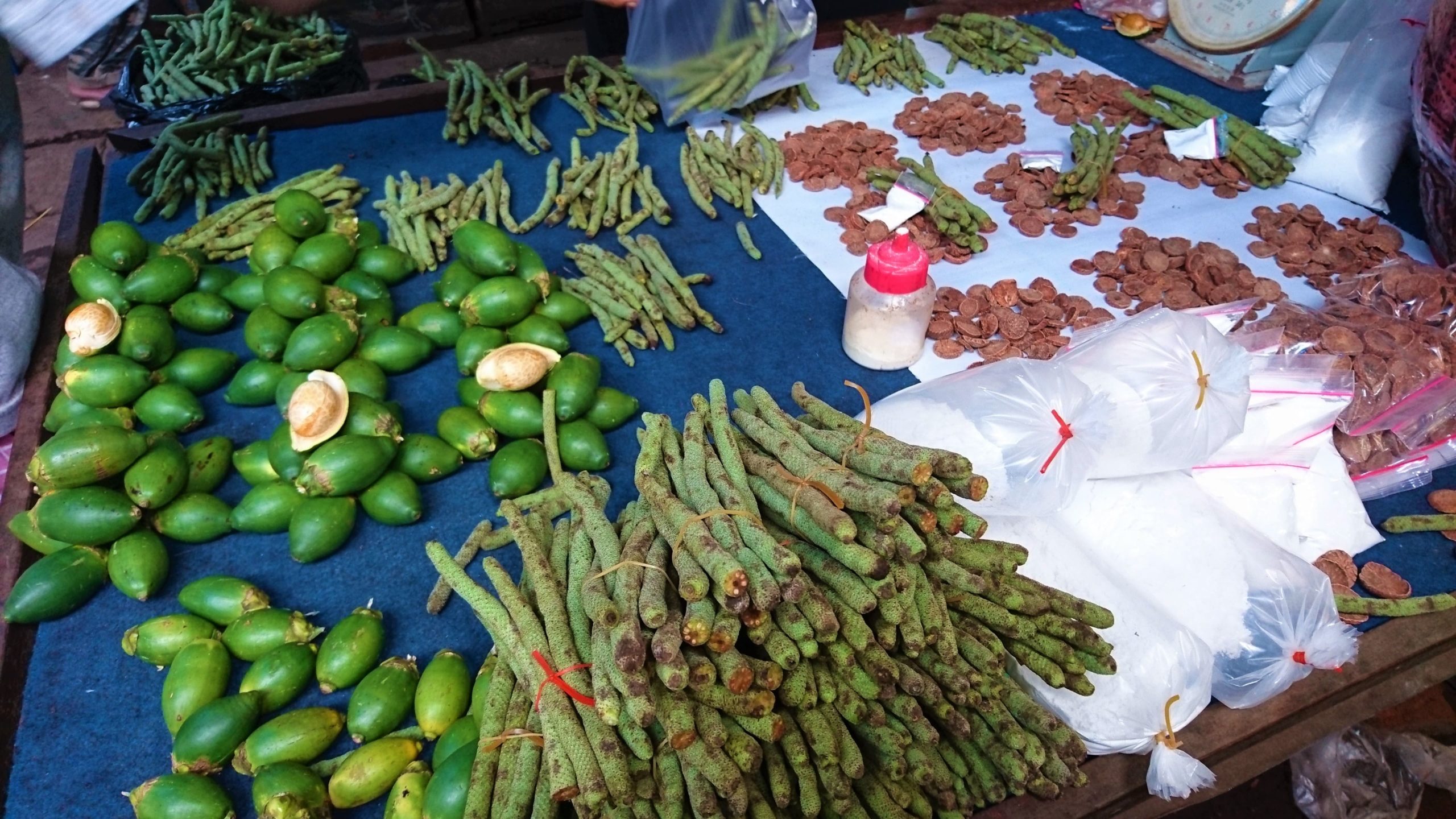If you walk around the streets of Papua, you’ll probably see them more than once. Street vendors sit behind a table with tiny piles of round green fruits in front of them. A green stalk and a plastic bag with fine white powder on top of it.
These three ingredients cause mouths to turn red, teeth to fall out and streets to get covered with red spots. Betel nut is also referred to as the “Green Gold of Papua”. Chewing is a hobby, basic income, lifestyle, and tradition. While in other parts of Indonesia, betel nut is slowly disappearing, consumption in Papua is increasing. Areca palms, the trees where the betel nuts grow, can be found everywhere. Betel nuts are one of the most dangerous legal drugs and nicotine, alcohol, and caffeine are the most commonly used addictive substance in the world. The effect? It differs from person to person but is usually described as a fast-stimulating high.
Let’s take a closer look at the intoxicating nut and find out how dangerous it really is!
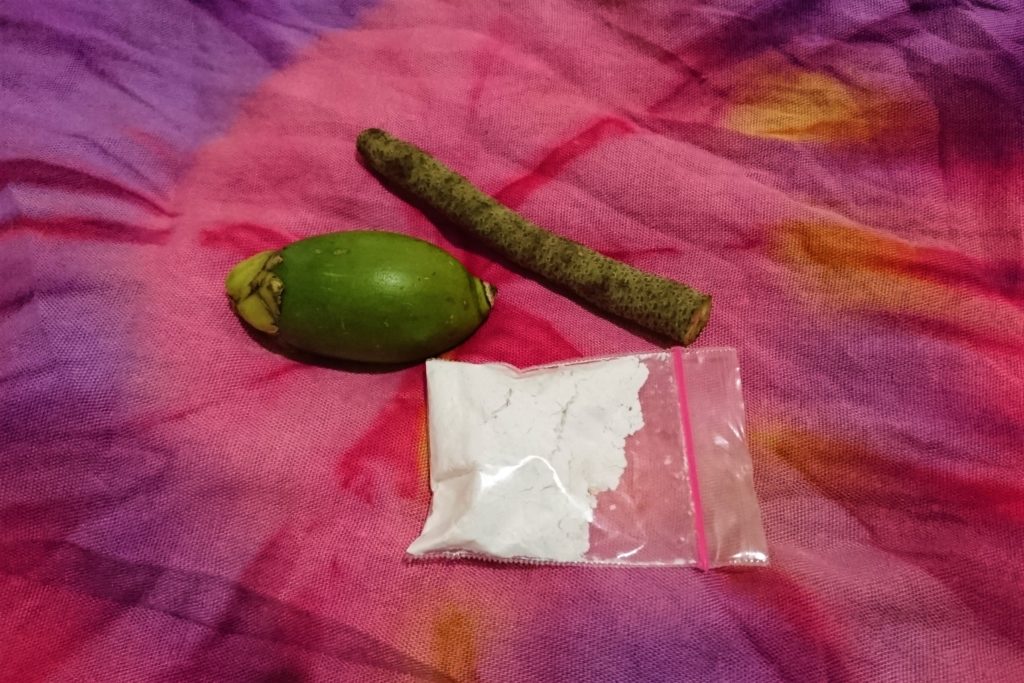
Where is the betel nut consumed?
Betel nut is mainly consumed in South and Southeast Asia and the Pacific Islands. Apart from Indonesia, there are some other countries where the nut is in high demand: Myanmar, India, Sri Lanka, Nepal, Guam, Vietnam, Bangladesh, and Taiwan are just a few. But none of them can beat the consumption of Papua New Guinea and the province of Papua in Indonesia.
Today we know that betel nuts were already consumed 4000 years ago. However, nobody knows who came up with the idea to combine the nut with a few other ingredients to enhance the intoxicating effect.
Today, around 600 million people chew the betel nut mixture. For many of them, the use of betel nuts is also the main source of income. Many people rely on the cultivation, harvesting, and sale of betel nuts. The untaxed betel nuts are also known as the “Green Gold” in Papua.
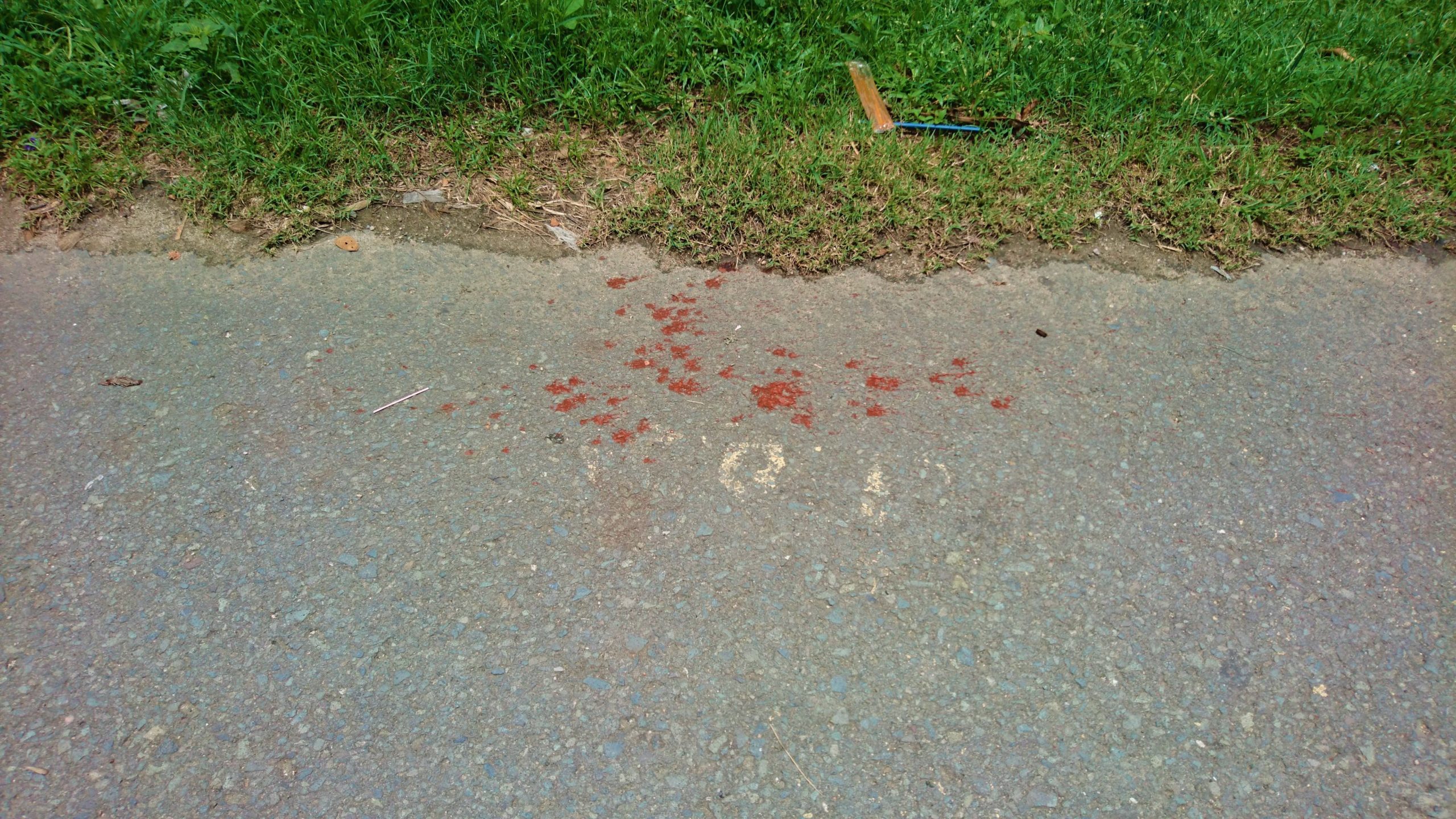
Chewing betel nuts is a tradition
Betel nut chewing has a long tradition in Asian culture and still plays an important role today.
Long ago, regular chewing sessions were held by the royals in Sri Lanka and India.
In Hinduism and Buddhism, betel nuts are used as important ingredients in various religious ceremonies.
In the Malay tradition, betel nut is used to welcome guests and on special occasions such as weddings, birthdays and even healing sessions. “Bagaikan pinang dibelah dua” means “cut like a betel nut in two” and symbolizes the connection of two persons in a marriage.
Although betel nut has always played an important role in Asian culture, it is slowly becoming a creeping epidemic in some of these countries. Governments are trying to control increasing consumption through official betelnut bans. In some areas of Indonesia, you can see signs where the chewing of betel nut is prohibited. Port Moresby, the capital of Papua New Guinea, is another example of the ban on betel nuts. The reasons for betelnut bans are the health risks associated with chewing and the red spots left by spitting saliva on the street.
The sale of betel nuts is prohibited in Australia. The possession of betel nuts is illegal in the United Arab Emirates.
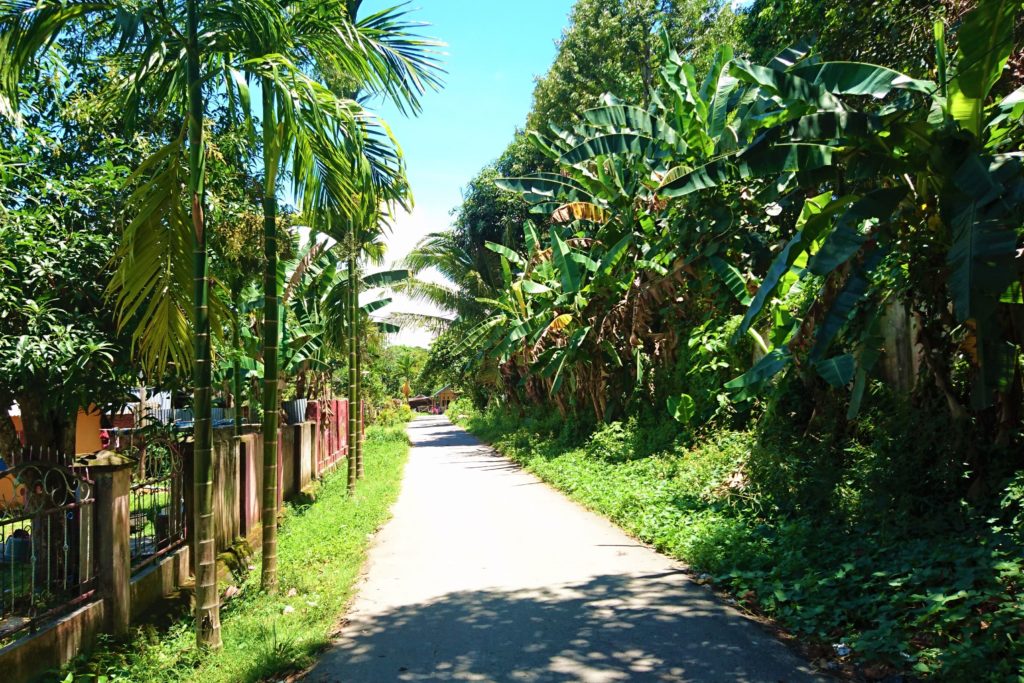
The main ingredient – the fruit of a palm
What we call a betel nut is rather a fruit than a nut. It is the Areca fruit of the Areca palm, a tree that grows up to 20 meters high. It has a straight stem and large star-shaped leaves at the top.
The fruit itself is about 5 cm long and has an outer fibrous husk that protects the seed – the nut – inside. Young fruits have green skin and a soft nut inside, which is easy to chew. The riper the fruits, the harder the nuts are inside. The outer skin changes colour from green to orange until it finally turns red.
The taste of the nut itself is slightly bitter. While chewing it the saliva increases, but at the same time a dry feeling remains in the mouth.
Due to its healing properties, the areca fruit is often used in traditional Chinese medicine and Ayurveda. Among many other things, it is believed to contain a deworming and anti-parasites agent.
However, the areca fruit contains alkaloids that affect the human organism. The main alkaloid in the areca fruit is arecoline. It affects the central nervous system and acts like nicotine. Arecoline can cause euphoria and relaxation and makes you highly addicted in a very short time. Long-term consumption of the areca fruit can result in serious health risks. Studies have shown that arecoline can increase the risk of oral cancers and other oral diseases.
Do you know another nut that´s rather a fruit than a nut?
Read The Coconut Part I: The nut that´s not a nut!
The second ingredient – the Piper Betel or Betel
Although it has the same name, the Piper Betel or simply Betel is not related to the fruit that we know as the betel nut. It is a vine of the pepper family. Their large, heart-shaped leaves usually have a fresh, slightly peppery taste, depending on the type of plant.
In India and Sri Lanka, the leaves are chewed after a heavy meal to improve digestion and refresh the breath. In Ayurveda, they are used to treat various types of diseases. In addition to the treatment of headaches, wounds, and indigestion, they have anti-inflammatory and aphrodisiac properties.
Also interesting are the fruits of the plant. While pepper is commonly known as small and round seeds, the fruits of the betel look more like thin sticks. Those seed pods taste refreshingly spicy and leave a numb feeling in your mouth.
The chewing of betel leaves or betel fruits has no harmful effects.
The combination of the betel with the Areca fruit intensifies the stimulating effect. At the same time, the Areca fruit tastes less bitter and makes the chewing experience more pleasant.
Slaked lime (calcium hydroxide)
Slaked lime or calcium hydroxide is made from limestone. The lime is burned and then extinguished by adding water, which gives it the name slaked lime.
The white powder has corrosive properties. It can be found as a food additive, in medicine, and in construction and was used in the past because of its antiseptic effect for the disinfection of stables.
In Papua, calcium hydroxide is extracted either from shellfish or coral. After burning, they are finely ground and extinguished with water. The consumption of lime can be dangerous because it can eat into soft tissue (such as the oral mucosa). According to the locals, shellfish lime is less harmful than coral lime. Whether that’s really the case, is a different story. Anyway, we never really know what lime is in the small bag when we buy the betel nut kit.
The reason for adding slaked lime to betel nut is to improve the absorption of the alkaloid stimulants of the areca fruit into the bloodstream. Only then you will experience the intoxicating effect. In addition, slaked lime is the reason for the red discolouration of the saliva when chewing betel nuts.
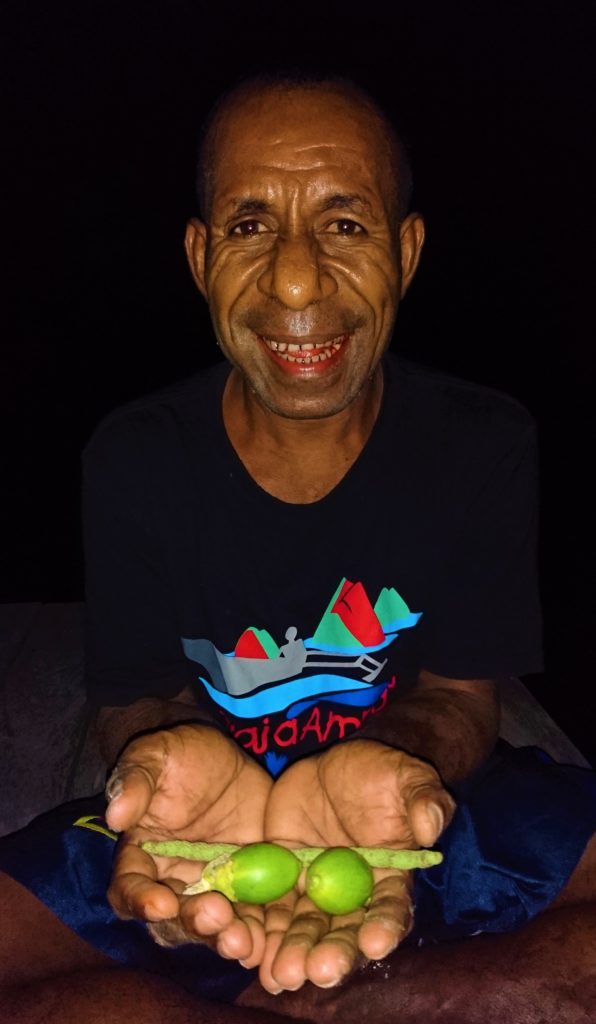
What are the effects of betel nut chewing?
Only if you combine these three ingredients, you can experience the full effect of betel nut chewing. When consumed separately, only a slight to no effect is noticeable. Because of its corrosive effect, the consumption of pure slaked lime is not recommended at all!
The first thing you’ll notice is increased salivation. Excessive saliva should not be swallowed but spit out. After chewing the betel nut mixture for a while, the saliva slowly turns red. The reason is a chemical reaction of the Areca fruit with the slaked lime and saliva. Next, your mouth feels slightly numb, especially in the area where you chew the betel nut.
Since the active ingredients are absorbed through the oral mucosa, it takes a few minutes for the first effects to be felt.
A warm sensation, mild dizziness, and increased alertness are the most common signs. The stimulants act on the nervous system. An increased heart rate, increased blood pressure and higher body temperature are the results. Consumers experience a feeling of happiness and euphoria. It is described as a short high as if one feels tipsy, but at the same time more active. Usually, this high doesn’t last long and after a few minutes, the next betel nut is ready to chew.
As with all other addictive substances, the more you chew, the less you’ll feel the effects. Many consumers chew betel nut daily and can’t imagine a life without it. Especially in areas where there are not many other activities, chewing betel nuts helps the locals throughout the day.
In addition, the chewing of betel nuts suppresses the feeling of hunger. For people living in poor areas, betel nut is a welcome substitute for food.
Betel nut in Indonesia: where and how is it consumed?
Although betel nuts can be found throughout Indonesia, it is mainly the older generation in rural areas that chews betel nuts.
As diverse as Indonesia is, so different is the way to consume the intoxicating nut. Often similar, sometimes different ingredients are added to suit the personal preferences of the consumers.
The old betel nuts are used in Java. The peeled, hard nuts, betel leaves, slaked lime paste (slaked lime with cold water) and gambir are crushed in a mortar. Gambir is a dye from the plant Uncaria Gambir and adds colour to the mixture. It is also said that it strengthens teeth and gums. After that, chewing tobacco is added. The traditional mortar for the betel nut is made from buffalo horn.
In Sumatra, the preparation is like in Java. Usually, cloves are added to the mixture to give it a special flavour.
In Bali, betel nut is consumed differently. The soft seed of a young betel nut is cut into thin slices and rolled into a betel leaf coated with the thick slaked lime paste.
In the Moluccas, mainly young betel nuts are used. The peeled, soft seeds are chewed together with betel fruits and white-slaked lime powder. Sometimes the older betel nuts are consumed after they are crushed in a mortar. If there are no betel fruits, betel leaves are used.
In Kalimantan, Sulawesi and Flores the preparation and consumption are like in Java.
Of course, the above methods are just examples. Many different variations can be found throughout the islands of Indonesia.
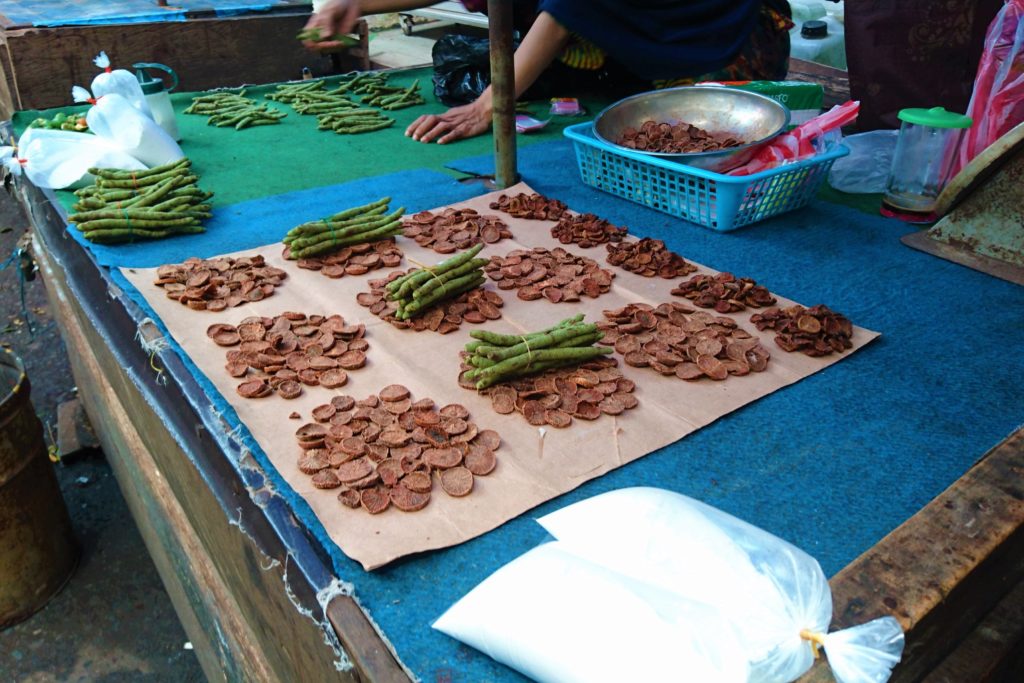
Betel nut chewing in Papua
While in many parts of Indonesia, betel nut consumption is slowly disappearing, in Papua it is increasing. You will see betel nut stalls on every corner, betel nut trees in front of the houses, and many people with red lips and teeth – young as well as old. It is part of the Papuan lifestyle and even in the smallest villages, there are enough supplies for everyone. Children as young as 7 years old follow in the footsteps of their parents and know how to chew the nuts properly.
As in neighbouring Papua New Guinea, the young betel nuts are usually peeled with the teeth of the consumer. The big difference, however, is that people in Papua also chew the fibrous husk that protects the soft seed. Without the outer green skin, of course. After chewing the betel nut for a bit, they dip the long betel fruits into slaked lime powder and place it on the chewed nut in the mouth (not on the soft oral mucosa). The excessive red saliva is spat out repeatedly until after a few minutes only the nut and the fibres remain in the mouth.
You can also find dried slices of betel nut at the stalls. These last longer than the fresh Areca fruits and are perfect for trips to more remote areas.
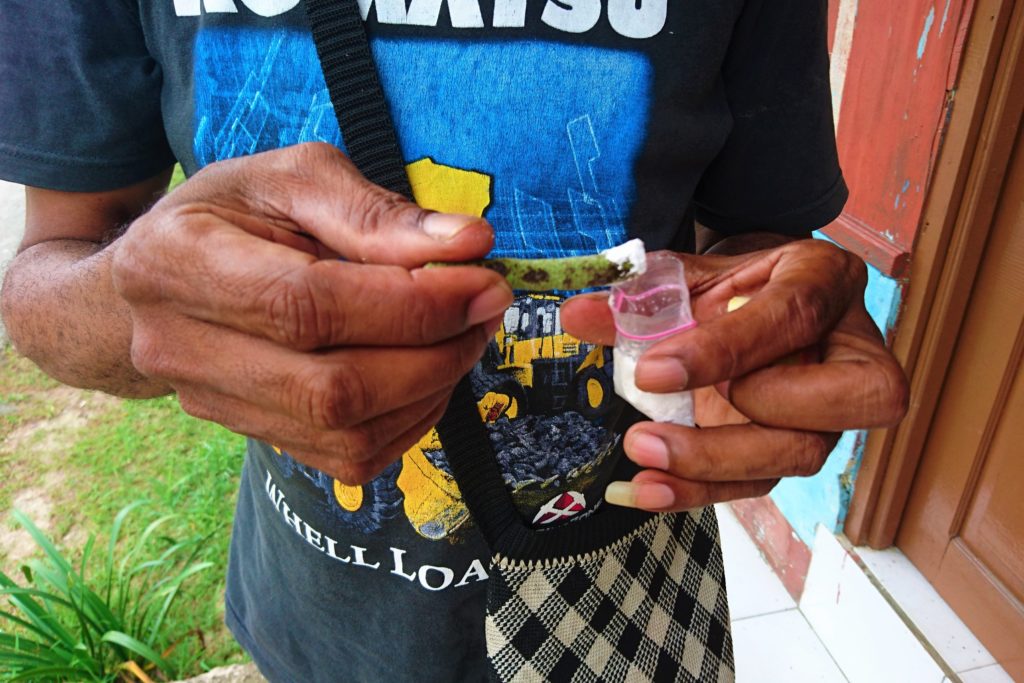
Different countries – different betel nuts
Indonesia and Papua New Guinea are not the only countries where chewing betel nuts is common.
Since 1990, betel nut has been the second most sold product in Taiwan (with rice being number one). Due to its stimulating effect, it was given to construction workers during the 1970s to increase productivity. In the 1980s, it was a symbol of Taiwanese identity and still plays a major role in Taiwanese culture today. Although consumption has declined since 2006 (due to increased information on the negative effects on health), there are still many stores selling betel nuts across the country.
These shops are usually recognizable by flashing lights and are located next to big roads. Their main consumers are truck and taxi drivers. Sold by beautiful girls in short dresses, you can find the whole fruits covered in betel leaf and slaked lime paste. Alternatively, you can buy the fruits without betel leaves, but with sweet red calcium hydroxide paste. Betel nuts are easier to cultivate than rice and the sale of “Taiwanese chewing gum” plays an important role in the economic system.
In India and Pakistan, the betel nut mixture is known as paan. After the harvest of the Areca fruits, a machine is used to peel them. The fruits are cooked in a red liquid made from the bark of the Jambhul fruit tree for 3 hours before being left to dry in the sun for a few days. They are sold in gunny bags to the shops that prepare them as paan, ready-to-eat betel nut bites. Often mixed with tobacco and spices such as cinnamon, cloves, cardamom or coriander they offer a completely new taste experience.
Myanmar is another country known for chewing betel nuts. Various street vendors offer various spice blends with the intoxicating betel nut. Betel leaves and slaked lime paste are always the basis for a variety of recipes.
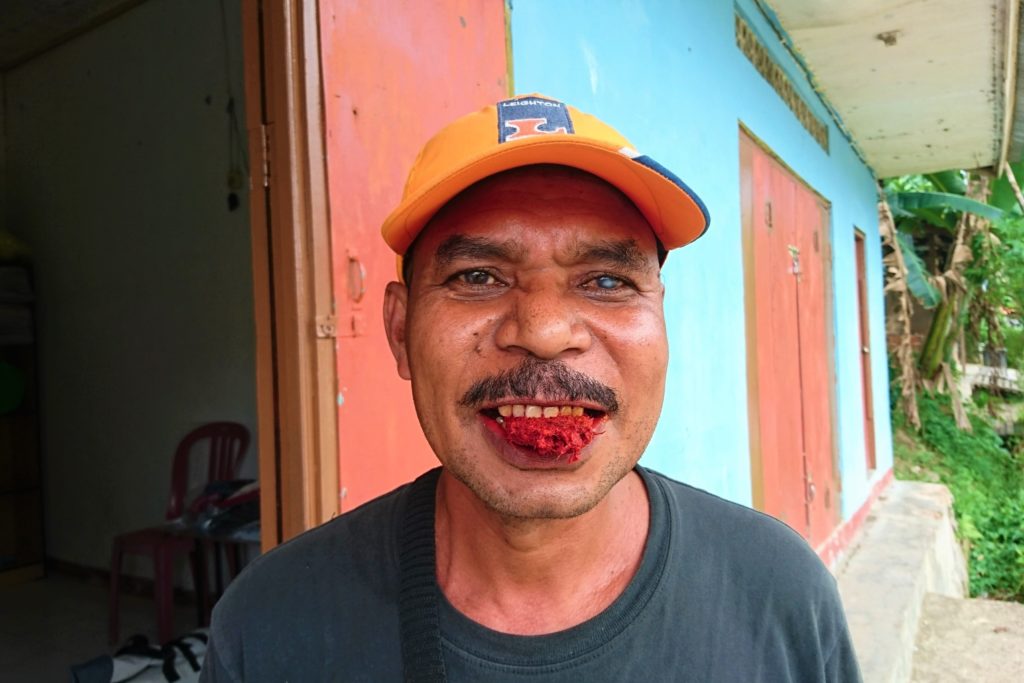
How dangerous is the chewing of betel nuts?
There is hardly any addictive substance that has no negative long-term effects.
The most obvious side effect for passionate betel nut users is the red discolouration of lips, tongues, and gums. The teeth also do not remain undamaged: the interdental spaces become red until, after some time, the teeth become almost black.
The red colour caused by the chemical reaction of the slaked lime is anything but healthy. In the long term, oral mucosa, gums, and teeth are severely damaged. In the worst case, the teeth fall out.
But far worse are the consequences that are not immediately visible. Studies have shown that people who regularly chew betel nuts are at an increased risk for oral cancer. And not only that – cancer of the oesophagus, lung, larynx, pancreas, and liver is more common in users of betel nuts than in non-consumers. Responsible for this is the arecoline of the Areca fruit.
Another serious problem is the red saliva covering the streets where betel nuts are consumed in large quantities. It is not only very unsightly but also unhygienic. Serious diseases such as tuberculosis are not uncommon in these countries and spitting out saliva increases the risk of contamination.
The country with the highest rate of oral cancer in the world is Papua New Guinea.
https://www.wcrf.org/dietandcancer/cancer-trends/mouth-pharynx-larynx-cancer-statistics
Although the official number is already high, we can assume that the actual number of cancer cases is much higher. In a country with limited health facilities, many cases remain unrecognized and undiagnosed. The health system is poor, medicines are not always in stock and the country has only a few oncologists.
Many symptoms related to cancer and other diseases appear after some time and are not associated with the consumption of betel nuts by most people. Others know about the harmful side effects but still can’t keep their hands off the intoxicating nut.
Once used for holy ceremonies, the betel nut now slowly kills half the population of Papua New Guinea. Traditional betel nut chewing has become a nightmare and the government is struggling to control the addiction of an entire nation.
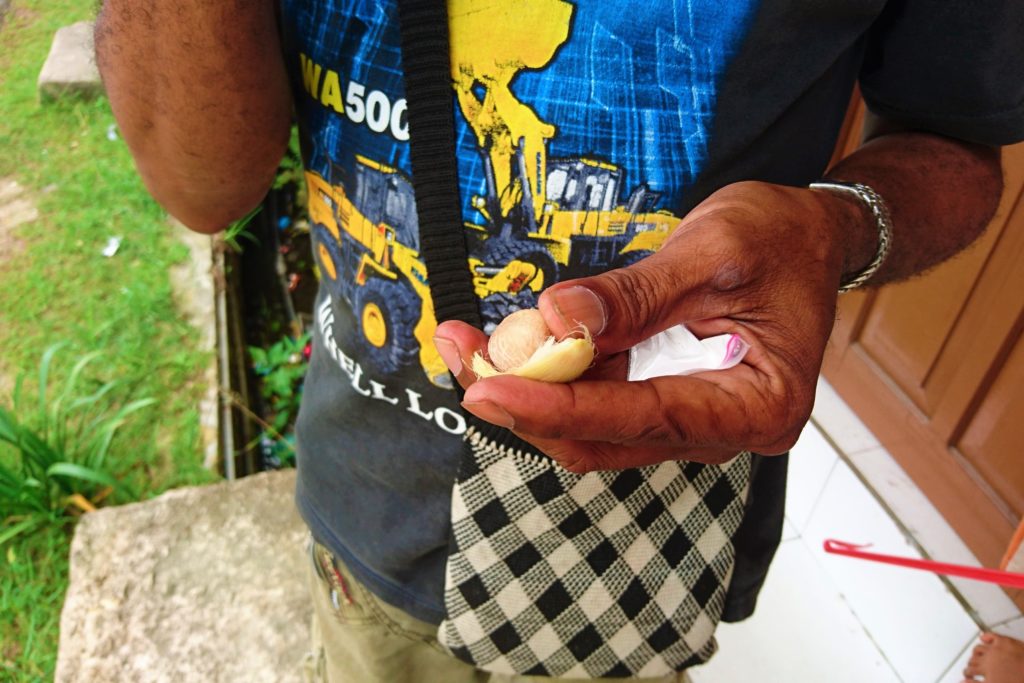
Never turn down an invitation!
Although the consumption of betel nuts can have some negative long-term effects, it shouldn’t be considered completely evil.
If you are invited by a local to a betel nut session, take this as a friendly gesture and try the nut at least once in your life. Be careful and follow the instructions of a local. However, consumption should be limited to special occasions only.
Joining for a chewing session with the locals is a great way to get to know their lifestyle and connect on a deeper level. And isn’t that exactly what we are looking for when we travel?
Read also 6 easy ways to get in touch with the locals in Sorong!
Have you ever tried the betel nut? How was your experience?

